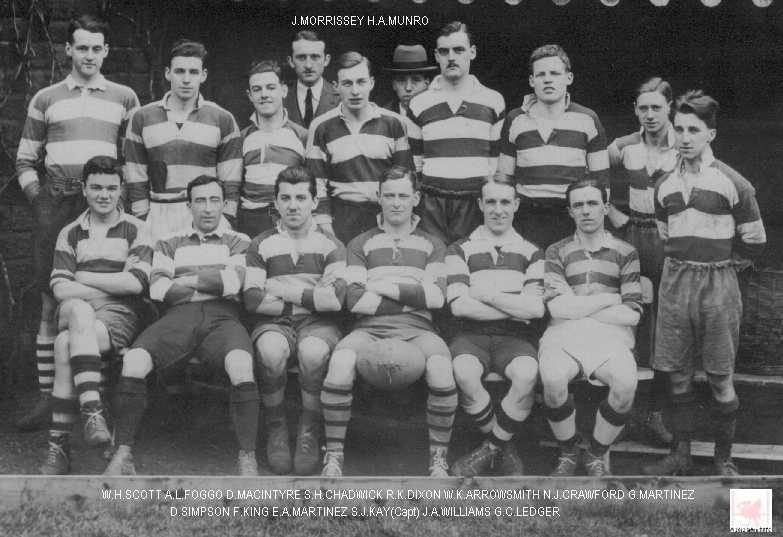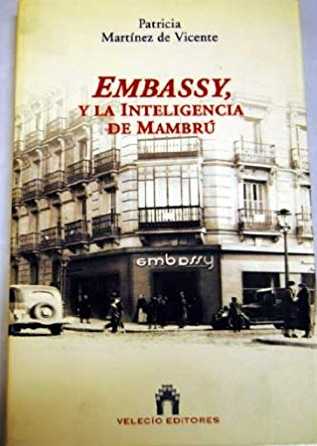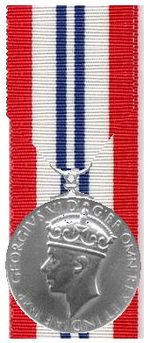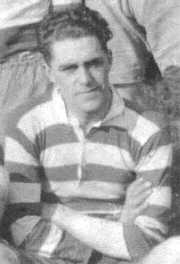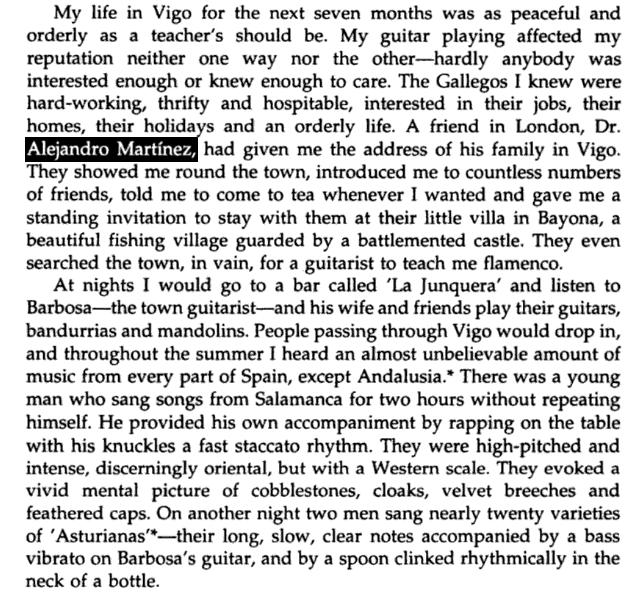Alien not Shaken and certainly
not Stirred
Written and researched by David
Bohl,
with the kind help of the Rule family tree and historians world wide.
The
intruguing story of E.A.Martinez
starts with his Uruguayan father, also Eduardo, moving from his
Consular post in Vigo, Spain to Glasgow in 1912.
Eduardo Snr became Consul in Liverpool in 1917, and his relations with
the shipping and commercial community of Merseyside were always most
cordial. He reached retirement age but in
appreciation of
his valued services, his Government asked him to continue in office (he
completed 25 years in total). He was greatly attached to
Liverpool, and had intimated that he would not accept promotion
involving his departure from the city. For many years, he and his
family lived in Alexandra Drive, Sefton Park with his wife, eight sons,
and three daughters. Seven of his sons were educated at Liverpool
University.
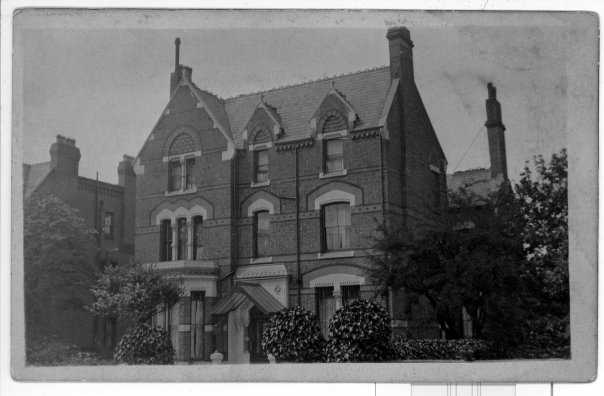
["Alhambra"
- Photo courtesy of the
Rule Family
tree]
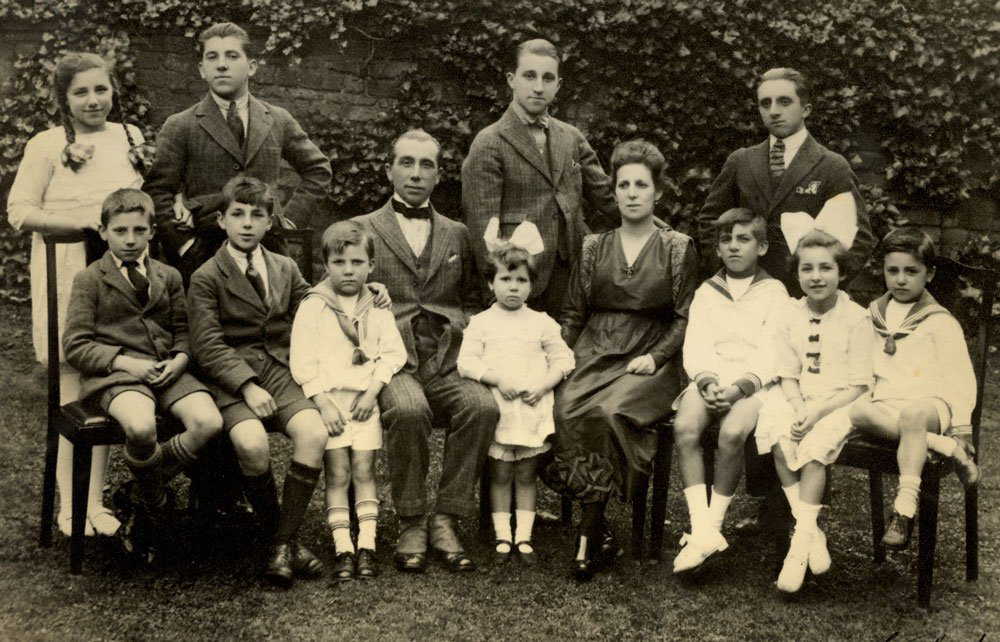
[Photo
courtesy of the Rule Family
tree]
Back Row: Sarah,
Eduardo Alonso, George
and elder brother
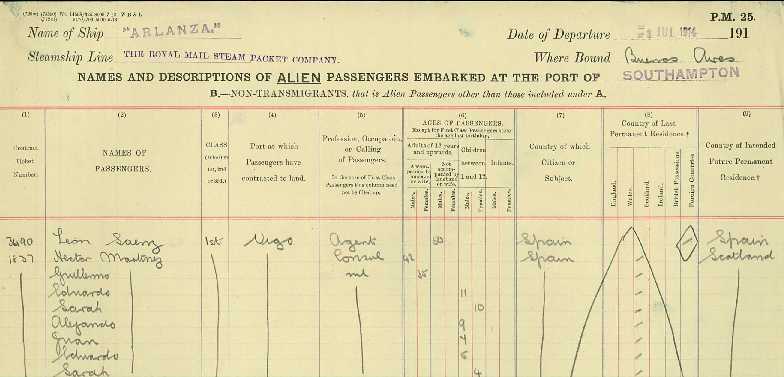
[The
children going on holiday to
Vigo in the summer of 1914]
Born in Vigo in 1903, Eduardo Martinez Alonso entered Liverpool
University to study medicine in 1918 and together with elder brother
George (b.1902), joined the Aliens shortly after their reformation in
December 1919. Their younger sibling Alejandro Juan started playing at
the
first opportunity in 1920 with Arthur(perhaps a cousin) playing in
1923-24.
[1XV
- 1920/21 Eduardo and George]
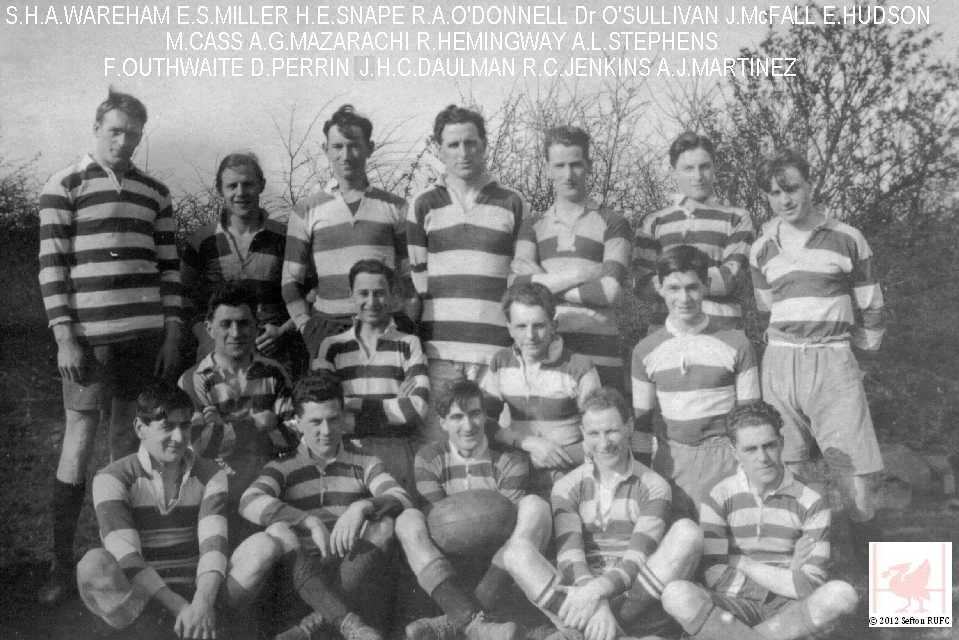
[1XV
- 1920/21 Alejandro]
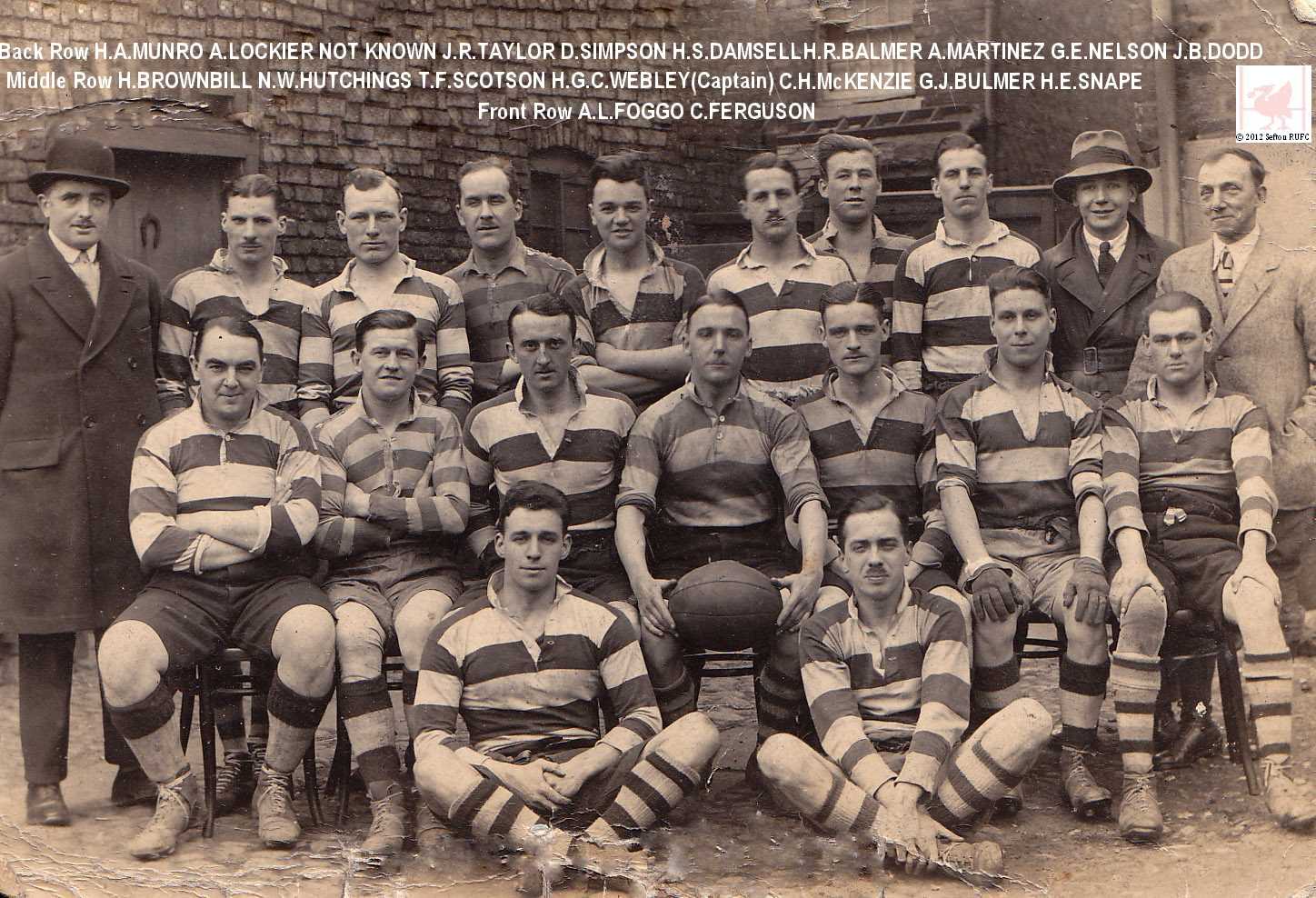
SEFTON
"A" v. WIGAN OLD BOYS
"A."
Played
at West Derby, ending in a
pointless draw.
Teams:-
Sefton "A": Kidd, Ovey,
Scotson, Morrisey,
Fraser, E
A. Martinez (captain),
G.
Martinez,
Kay, Darbyshire, Cornick,
Simpson, Snape, H. W. Jones, V. Jones,
and Price.
Wigan
Old Boys 'A': F. Payne, I.
Dodson, G.Scott, H.
Scott, H. Booth, J. H. Roberts, H.Baxendale, A. H. Crawshaw, W. Lang,
A. R. Martland, J. Lea (captain), H. Peacock, H. Leyland, E. Lupton,
and A. Goodyear.
The
Wiganers were up against a stiff
proposition
in that their opponents had not lost a match this season. The game was
of a gruelling nature, and only the determined tackling of the visitors
kept Sefton out. The brothers Martinez were a clever combination and
took a lot of stopping. The Old Boys certainly deserved all praise,
especially as they had two tries disallowed.
Wigan
Examiner 24/10/1922
When
Eduardo qualified in Medicine he was uncertain
what his
next step should be, and his
mother, possibly keen to free up a little space in the house where he
lived with his two older and eight younger siblings, suggested that his
grandmother in Madrid would be delighted if he went to stay with her.
In September of 1924 both Eduardo and George resigned from the club.
Taking the huge hint off his mother Dr Martinez set off for Madrid and
took further medical degrees. He was soon in high demand as an English
speaking physician, one of his patients
was Queen Ena, the British wife of King Alfonso.
In
normal circumstances we could usually finish this
life story off with one sentence and say he continued to be a
successful thoracic surgeon in Spain, but, he published a book in early
1960's illustrating heroic service to the Allied cause in the
Second World War.
'Adventures of a
Doctor' is a very rare
book to find, but luckily a precis has been written recently
by Caroline
Angus Baker
Just in case the link disappears in the future here is the review in
full, our great thanks to Caroline:-
EDUARDO
MARTÍNEZ ALONSO
SPAIN BOOK REVIEW: ‘Adventures of a Doctor’ by E.
Martínez Alonso
PUBLISHED ON February 18, 2014
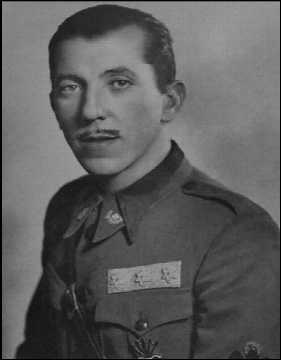
[Adventures of a Doctor
by Eduardo
Martínez Alonso seems to be so rare, I can’t find
any
cover art or a blurb about this book. I managed to purchase a damaged
copy from the New Zealand parliamentary library, and when they tossed
this book to me for a mere $6 (about €3.60), they obviously
didn’t know what a treasure they had. Eduardo
Martínez is
quite an extraordinary man with a story that seems to have been largely
lost. With the market flooded with 1001 Spanish civil war books, it
comes as a great surprise that this book doesn’t get more
recognition.
The
story starts
with the author born in Vigo, Galicia in 1903. His father was from
Uruguay, and was the consul in Vigo. As a young boy,
Martínez
travelled to his father’s homeland, along with his family (he
was
one of eleven children, and talks of his mother constantly having to
nurse his siblings). The story tells of life in northern Spain in the
era, and exploits with his brothers and attending a boarding school
with mixed success. In 1912, Martínez’s father
received a
post to Glasgow, and the whole family moved north for a new life.
Martínez dreamed of working in hotels or on ships, able to
meet
people and travel far and wide. He became bilingual at a young age,
seeing the benefit of speaking Spanish, English, French and more. But
it was his father who said he would be a doctor, not a sailor. As each
of the eight boys grew and carved out professions (sisters, of course,
were to be wives and caregivers), the prophecy of the hard-working
consul came true. The family and Martínez recalls the first
world war, his school years and an eventual trip back to Uruguay.
As a
trained
doctor, Martinez moved to Madrid with his grandmother, and speaks of
seeing Anna Pavlova dance at Teatro Real, with the King and Queen in
attendance. He quickly took up a post at Red Cross Hospital, and met
Queen Ena, British wife of King Alfonso XIII, and the Duchess of
Lecera, who were delighted to have an English-speaking doctor. News
travelled of an English-speaking doctor in favour with the queen, and
Martínez was in hot demand. Just eighteen months later,
Martinez
graduated from San Carlos Medical Facility and while meeting the King
and Queen socially and professionally, was appointed the medical
adviser to the royal family. This proved to be an amazing and dangerous
post.
When
the Second
Spanish Republic was founded in 1931, Martínez was in the
palace
in Madrid with the royal family as they were deposed. He tells of
sitting casually with Queen and princesses as the monarchy fell. As the
family were forced into exile and as Spain underwent revolution,
Martínez’s position as a monarchist him an easy
target. As
civil war came five years later, things changed dramatically.
Martínez got his family out of Spain in July 1936, or off to
the
safety of Vigo, and knew he would be in danger as a former royal family
aide. Through his work for the Red Cross, he was ordered by a Communist
faction to work as a doctor for the Republican side of the war.
On
Saturday morning
the shooting started. We sat in a bar and heard the crackling of
machine guns, the burst of hand grenades, and I saw smoke arising from
many quarters of Madrid. By Monday morning a general strike had been
called. Everything was paralysed except murder, arson, and rape. The
Spanish civil war had commenced – Pg 70
Martínez
talks of watching a church burning as priceless works of art were set
alight along with the riches of the churches of Madrid. He saw a priest
thrown on the flames but was unable to save his life when he pulled the
screaming body from the blaze. Most priests were taken out to Casa del
Campo to be shot. Men were burning priests but trying to revive pigeons
which fell from bell towers, overcome by smoke. Martínez had
an
apartment in Madrid, and he hid as many people as he could throughout
the war. Nuns and priest were hidden, and forced to serve meals to men
who sat and spoke of vicious murders they had committed against the
clergy.
Martínez
was
posted to a town outside Badajoz, Cabeza del Buey, in the south-west,
working for the Communists. While running the hospital, a young nurse,
Guadalupe, suggested they flee and work for Franco’s troops
instead, but Martínez seemed convinced that he would be
killed
at some stage, regardless of where he was posted, and claimed no
political alliances. In Cabeza del Buey, he was forced to attend mass
executions of seemingly innocent men, and despair at violent speeches
about revolution and vengeance. He performed many surgeries and saved
lives in the most atrocious conditions. But with no warning,
Martínez was shipped off, with Guadalupe, and sent to
Ocaña, just outside Aranjuez, to work in the prison there,
and
be a prisoner himself. As he had in Cabeza del Buey, Martinez managed
to get some nuns freed from prison to work as nurses, and treated
patients while living in a cell himself. Between dire conditions and
deadly activities, a patient told Martínez that his turn to
be
executed was near. An in understated manner, Martínez talked
of
his prison escape to Valencia in March 1937, were he managed to procure
a fake passport and get aboard the Maine, a ship bound for Marseilles.
Martínez
quickly got himself back in Spain, despite the dangers. He chose to
cross the lines and work for the ‘white’ side of
Spain,
Franco’s rebel army. Red Spain (the Republicans), he felt,
thought nothing of him, his work, and long suspected their cause would
lose the war, one they never had a chance to win. Posted to Burgos,
Valladolid and then San Sebastien, Martínez then found
himself
working on the front lines as Franco’s army continued to
advance
into enemy territory. Towns fell one by one as Martínez
fought
to save lives, but writes in such a humble, unassuming manner. Once in
Zaragoza, Martínez worked hard to care for patients at the
hospitals, and pioneered the use of closed casts on wounds, a procedure
first tried with less success twenty years earlier. Despite the smell
offending wealthy female volunteers, Martínez’s
experiment
helped the lives of many patients otherwise in agony as they recovered.
He was then moved on to his own mobile surgical unit in Teruel in 1938.
Martínez
was
there on the ground when troops stopped in Sarrión, 100kms
north-west of Valencia, as the war finally came to its brutal end. On
April 1st, 1939, the war was over and declared won by Franco in this
small town, and after helping a man and his son to Valencia,
Martínez sought out all those who had helped him during the
war,
and moved back to Madrid. No sooner than Martínez had helped
his
friends and former nurses, and begged for clemency for some condemned
to death by the new regime, the second world war broke out. With some
family in Vigo and some Britain, travelling on multiple passports,
danger was again faced. As Hitler plowed through Europe, Madrid
suffered greatly after the civil war and Martínez went to
work
at Miranda de Ebro, near Burgos, to help war refugees from all nations.
With such a humble attitude, he glossed over his feat to aid refugees
out of Spain, saving their lives, until in 1942, when his ferrying of
innocents was discovered and he was forced to flee Spain. His time
working with British Naval Attaché, Captain Alan Hillgarth
is
barely touched upon, but should surely serve as an incredible tale of a
man saving lives at great risk to his own. This two-year period alone
could serve as a story all of its own. Just his dramatic escape would
serve as its own story, but the author covers it in a few sentences,
and neglects to mention he fled with a new wife. He also failed to
mention his first marriage which produced two children, but was
annulled after Franco took power in 1939 (His wife was a British woman
who went home without him). I only found about either marriage after
studying the doctor further myself. There are no clues to whom these
women are at any point in the book. His personal life is never touched
upon.
Again,
Martínez talks little of his involvement with the rest of
the
world war, after being detained when first arriving in Britain (no idea
if his Spanish wife was also detained), but worked as a spy for Britain
throughout and barely talks about it. He worked at Queen Mary Hospital
after the war and oversaw great new procedural advances, meeting some
of Europe’s finest surgeons, but then returned home to
Madrid.
Life was hard in the beleaguered nation, and he again went to work at
Red Cross Hospital, specialising in chest surgery. He then moved on to
working as the doctor for the Castellana Hilton, newly opened in 1953.
He recounts stories of wealthy Americans, and famous movies stars
(unnamed) alike, who came to Madrid for all sorts of reasons. He spoke
with frustration at his patients demanding penicillin shots, not
wanting to discuss why they need this medication. Many guests, male and
female, had a penchant for sleeping around and wanting medicine to
atone their sins, either before or just after the liaisons which bore
infections. One guest talks of being raped and demanding penicillin,
though the story is far from convincing to the doctor. Sexual
liberation had come to the foreign guests at the Hilton, and expected
Martínez’s penicillin to cover it up. He makes his
disdain
clear for these patients and the abuse of this groundbreaking
medication, and of the myriad of alcoholics he was forced to attend to,
when little could really be done for them.
The
book is written
in the manner of a doctor – no-nonsense, no fussing with
detail,
just the raw facts given out without prejudice. Martínez is
a
man with the story worthy of a Hollywood blockbuster, but it
wouldn’t be his style. This book was written in 1961, and
Martinez lived until 1972. It shows what really stood out to the doctor
in his life, because details are excluded, and there are many secret
operations he simply never wanted to discuss. He is free and easy with
dates – because I know the civil war, I could piece together
the
timelines of the book, but needed to look up world war details and the
opening of the Madrid Hilton, just to give myself an idea of how much
time passed between chapters.
*above photo taken just prior to release from the Spanish army, 1939.
Photo supplied in the book (page 112)]
So
it looks like we have a real life
Spanish episode of "Hola, Hola"
on our hands, but the lid really came off events in 2005 when
a
Special Operations
Executive file held at
the National Archives in Kew was de-classified.
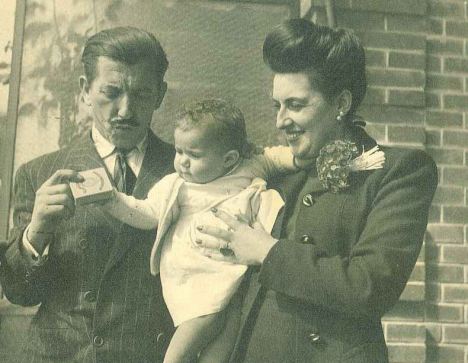
Martinez’s
daughter, Patricia
Martínez De Vicente became aware of this and after
a
lengthy trawl through all this unknown
fascinating information she wrote a book called "The Enclave,
Embassy".
Another
online article by Nicholas Coni
combines 'Adventures of a
Doctor' and 'La Clave, Embassy' entitled Surgeon
Who Undertook Special Operations
Once again just in case the link disappears in the future here is the
page in full, our great thanks to Nicholas:-
Surgeon
Who Undertook Special Operations
Correspondence:
26 Brookside,
Cambridge CB2 1JQ, UK
(email Nick.coni@ntlworld.com)
[Although
he was
born in Vigo in 1903, and although his name and
ancestry are Spanish, Eduardo Martínez Alonso qualified in
this
country
and a curious sequence of adventures led him to pursue his career in
Spain and to his heroic service to the Allied cause in the Second World
War (WWII).
Education
and early
professional life
Eduardo’s
father, a lawyer, was posted to Glasgow as the Spanish
Consul
in 1912, but was subsequently transferred to Liverpool, and after his
school days in Scotland which he describes well in his
memoirs¹
(the
present account is based on his book and that of his daughter²
except
where other references are given), the young man entered Liverpool
University to study medicine in 1918. When he qualified, he was
uncertain what his next step should be, and his mother, possibly keen
to free up a little space in the house where he lived with his two
older and eight younger siblings, suggested that his grandmother in
Madrid would be delighted if he went to stay with her. She was a
well-connected lady, her uncle having been one of the many young
officers who attracted the attention of Queen Isabella II and having
become a general, a duke and the Viceroy of Cuba. While staying with
her, Martínez was introduced to the Chief of Surgery at the
Red
Cross
Hospital, which had been founded by the patron of the Spanish Red
Cross, King Alfonso XIII’s wife Victoria Eugenia of
Battenberg
(“Queen
Ena”, grand-daughter of Queen Victoria, born in Balmoral
Castle
in 1887
and, as events would show, a carrier of haemophilia), who visited
almost daily. She seems to have been pleased to meet an
English-speaking doctor and offered him a position as an intern in the
hospital, and while in this post he graduated from San Carlos Medical
Faculty, Madrid, and embarked upon his surgical training. His
grandmother obligingly moved to a larger apartment which could
accommodate his consulting rooms as well as the x-ray machine which she
bought him. Here, he performed minor procedures when not assisting at
major operations at the hospital, and it is clear that his practice
flourished; he visited surgeons in Paris and London, and was appointed
medical adviser to the British and American Embassies. He met the King,
helped to look after a close relative of the Queen, and was informed by
her that she had recommended to her husband that he be nominated
medical adviser to the Court – when, in 1931, the Monarchy
was
firmly
rejected by the electorate, the Second Republic was declared, and the
Royal Family hurriedly departed into voluntary exile.
Martínez’
memoirs are exceedingly short on details of his
personal
life, and he makes no mention of the marriage which he contracted to an
Englishwoman, ex-wife of a scion of the De-Havilland aircraft
manufacturer, with whom he had two children. She left for the UK, never
to return, and this marriage would become retrospectively invalid under
the new regime in 1939 as it had not been celebrated in a Catholic
church, leaving him free to marry a boyhood girlfriend from Galicia.
Civil
War
It does
not appear
to have been until the outbreak of the Civil War in
July 1936, that the upheavals that were ravaging Spain, really started
to impact upon him. It became necessary to simulate a revolutionary
fervour that one may or may not have felt, and some flavour of the
times can be drawn from his account of a dinner party which he hosted
which is also described in strangely similar words by one of the
guests, a somewhat unreliable American journalist from the flat below.
The other guests were a couple of anarchist militiamen, whom
Martínez
had clearly thought it prudent to invite, and who, under the influence
of their host’s liberal copas of Valdepenas, described the
unspeakable
barbarities which they had just been inflicting on two unfortunate
priests – blissfully unaware that the two maids who served
them
were,
in reality, nuns in disguise whom Martínez was sheltering
together with
a priest who was hiding in the next room. Martínez protests
throughout
his memoirs that he was at all times entirely apolitical – as
well as,
apparently, having been agnostic and somewhat anticlerical himself
–
and that he practised his profession totally indifferent to the
allegiances of his patients. There is no real reason to doubt him, but
our beliefs are conditioned to some extent by our upbringing, and it
was inevitable that his loyalty to the Republic would be suspect. This
was more than sufficient reason, in those terrible days, to earn a
denunciation and a summary sentence to a one-way paseo. He learned that
his name had been on a list of those to be executed, but scratched out
due to the intervention of the staffing officer of the hospital, who
was an influential communist and who demanded in return that he offer
his services to a communist surgical unit.
Thus it
was that he
found himself surgeon to a field hospital near
Badajoz, where his most distressing duty was having to witness a mass
execution in his capacity as Medical Officer (MO). His nursing
assistant and confidante suggested they cross to the other side, but he
responded that they were needed more where they were, and that in any
case, if they crossed the lines they were bound to be shot by one side
or the other. He attended to a stream of casualties from the front
line, but was shortly arrested and thrown into a jail in
Ocaña,
just
south of Aranjuez, where he organised a prison hospital, liberating
some incarcerated nuns to help him, and soon became free to visit
nearby military units. The engineer officer in charge of the
maintenance of the ambulances had been a taxi driver at the Palace
Hotel in Madrid whom he had often employed, and one evening while they
were dining together, the engineer was approached by a group of
anarchists who attempted to persuade him, by shooting him through the
jaw, that he should issue petrol to them in the line of duty, rather
than sell it to them. As Martínez was attending to his
wounds,
the
engineer advised him that he must escape as soon as possible or he
would be taken on a paseo.
Escape
to “White” Spain
When
Franco’s
troops crossed to the east bank of the Jarama on
the 11th
January 1937, the International Brigades bore the brunt of stopping
their advance, and it soon became widely known that there was a prison
hospital at Ocaña where the head surgeon spoke English. This
became
designated the main evacuation centre for casualties, and beds were
freed up by the simple expedient of shooting the prisoners. Appalled by
this measure, and desperate for support in the management of the 400
casualties who arrived daily, Martínez sent cables to the
senior
MO of
the Republican Army, Dr Recatero, fiercely critical of his management
and demanding assistance. He was himself accused of criminal neglect,
and collapsing onto his bed after leaving theatre at about 3 a.m., he
was woken up by Recatero and his henchmen, who had come to execute him.
His former taxi driver appeared miraculously on the scene, and relying
on the eloquence, so persuasively used against himself, of a pistol
barrel, convinced Recatero that he should abandon his mission. The next
day, Martínez was driven to Valencia by his rescuer
disguised as
a
casualty, while café radios blared out his name and
description.
Furnished with a false passport, the British Embassy arranged passage
to Marseilles on HMHS Maine; from there, he travelled by train to St
Jean de Luz and thence was driven by the American Consul over the
border to San Sebastian, where he caught another train to Burgos. After
security clearance he enlisted in the Nationalist Army and was sent to
the Basque front, where he noted “…then came
Guernica,
which our German
allies erased from the face of the earth in a bombing raid which raised
an outcry throughout the world”. Following the campaign in
the
north,
he was posted as senior surgeon to a base hospital in Zaragoza, whence
he wrote to a medical friend in the UK:
“To
cut a
long story short, I broke prison on the 1st of March,
with a
little outside help and eventually reached Valencia where I literally
threw myself into the hands of the British Embassy. Finally I got
aboard the HMHS Maine which took me as far as Marseilles, and here I am
after nine months of campaign in the north, very happy to be on this
side and in the thick of things…Many of our friends of the
International Congress of the History of Medicine have been shot by the
reds…Please do what you can and help us stamp out communism
[e.g.
supply surgical instruments]…”(5)
Surgeon
with the Nationalists
In
Zaragoza,
“A team of distinguished and, in some cases, pretty
ladies
from the aristocracy … would come in every morning in
Nursing
Auxiliary
uniforms, don rubber gloves and face masks, fill syringes with hydrogen
peroxide solution, and go from bed to bed washing out the festering
flesh and rotting bone.”
All the
patients,
inherited from his predecessor, were suffering from
chronic infection of their wounds. Martínez, who claimed
that he
was
the first [in the world? on the Nationalist side? in that hospital?] to
practise “what was later called the ‘Spanish
cure’” [as described by
Trueta in 1939, but strikingly lacking Trueta’s emphasis on
débridement, a grave sin of omission even in a book for
laymen],
put
the limbs in plaster, and found over the next few days that the
patients were much happier, with normal temperatures and hearty
appetites, but that the distinguished ladies were very unhappy since
they had little to do but complain about the smell. One of them
reported her dissatisfaction to the medical superintendent, who
reported him to the chief MO of the sector, who posted him to a
hospital train, “the worst invention of the Spanish Civil
War”. It does
sound, from his description, as if the wagons had been very poorly
converted for use as operating theatres and wards, and that it was the
implementation rather than the concept which was at fault. His
complaints again earned him a rebuke and a posting, this time to the
campaign to recapture the frozen city of Teruel. There, he set up
hospital in an abandoned church and had to contend with numerous cases
of trench foot and gangrene as well as the wounds inflicted by enemy
action. His experience of serious trauma may have prompted him, some
months later, to write to his British friend requesting some pitressin,
clearly intended either as an established or experimental treatment for
shock.
After
the war he
was sent to Madrid, to food rationing and to a typhus
outbreak, to take over a Military Emergency Hospital. The epidemic was
due to the release of louse-ridden prisoners from concentration camps,
and his former tormentor, Colonel Recatero, was identified in one of
these camps, disguised as a “common militiaman” and
was
charged with
the execution of 29 doctors, and would undoubtedly have faced the
firing squad himself but managed to elude his captors for long enough
to leap from a fourth-floor window with a very similar outcome.
Second
World War
The
outbreak of the
war found him re-established in his practice in
Madrid where he was also the MO to the British Embassy and where, in
consequence, he was responsible for the medical care of British
subjects and other Allied servicemen who had entered Spain as fugitives
from Nazi-occupied Europe. The latter were interned in one of several
concentration camps, mainly that originally established for Republican
prisoners of war in a town near Burgos with the charming name of
Miranda de Ebro, which belied its evil reputation; designed for 500
inmates, it eventually held 3,500 in conditions of hunger, poor
sanitation and extremes of temperature which were in part, at least,
attributable to the economic plight of the country. On his visits
there, Martínez took provisions, cigarettes, and irons
capable
of high
temperatures to destroy the lice in the clothing being pressed.
There
followed a
period from 1940 to 1942 which Martínez
dismisses with
a tantalising lack of detail in his memoirs, through loyalty to his
comrades whose identities he was sworn to keep secret. During this
period he and the British Naval Attaché, Captain Alan
Hillgarth,
conspired to establish a most effective network through which they
spirited very substantial numbers of Jews from various nations, and
other fugitives including servicemen, agents, and persons of importance
to the Allies, through Franco’s pro-Axis, Gestapo-infested
Spain
to
Gibraltar, or Portugal, and freedom. Hillgarth and his colleagues in
the Special Operations Executive (SOE) may have been the prime movers,
but Martínez, with his contacts and knowledge of the
terrain,
and
motivated partly by anglophilia but mainly by sheer humanity, was the
organizing genius behind these proceedings. A great deal of information
about his clandestine activities has been unearthed by his daughter, a
social anthropologist, and although he never spoke about these
exploits, she fortuitously discovered his diary from that era when
selling his flat 15 years after his death in 1972. She pursued the
revelations it contained, through the interrogation of her mother, then
aged 80 but still possessing an excellent memory, as well as through
archival sources. Although her mother had known little of the nature of
Martínez’ undercover operations at the time, she
was able
to recall
many of the meetings and comings and goings, and, having maintained
contact with Hillgarth after her husband’s death, was able to
confirm
much of the account that her daughter was able to piece together.
Another friend who witnessed a number of what were at the time, to her,
mysterious events was Consuelo Alan. This lady’s mother, a
redoubtable
Irish lady called Margarita Taylor, ran a café rather
confusingly
called “Embassy”, frequented by the
élite of Madrid
society, and where
not only did the conspirators meet discreetly under the very noses of
the SS, but where many of these fugitives would be concealed for a
night or two before proceeding on their perilous journeys.
It is
necessary to
digress to outline the situation in Spain during the
early years of WWII. It may be too simplistic to say that Franco would
never have won the Civil War without all the assistance he received
from Mussolini and Hitler(6),
but it most
certainly helped, and there
seems to have been a strong possibility that Spain might have entered
WWII on the side of the Axis, in spite of a setback at the historic
meeting between Hitler and Franco at Hendaye in October 1940(7)
(Preston
1995: 393-400). Franco certainly made anti-semitic noises in some of
his speeches(8),
but it is far from clear
that anti-semitism formed one
of his core beliefs (if, indeed, he held any). Meanwhile, it was
Churchill’s profound hope that Franco would stay out of the
war,
and
this was the mission he entrusted to the ambassador whom he posted to
Madrid, Sir Samuel Hoare. Hillgarth also enjoyed Churchill’s
confidence, and received ample funding for the expanded role which he
played throughout the war.
In May
1940, the
Germans overran Holland and Belgium surrendered, and
the following month, Marshal Pétain signed the surrender of
France.
Tens of thousands of refugees fled over the Pyrenees hoping to cross
Spain to freedom. The Spanish authorities were initially very
accommodating to all except men of military age, but the Vichy
government soon made it difficult to leave France by restricting the
issue of exit visas, and the Spanish refused entry to anyone without
one. In 1941, under pressure from Germany, the Spanish regulations
became progressively more irksome, although they did not distinguish
between Jews and non-Jews, but in the summer of 1942 the Vichy
government cancelled all exit visas for Jews and without them, they
were unable to obtain Spanish transit visas. The result was an increase
in the number of illegal “indocumentados”
throughout 1940
which
accelerated during the subsequent two or three years, and these were
liable to indefinite imprisonment which, in the case of men, usually
meant the harsh conditions of Miranda de Ebro. During the early years,
some refugees were turned back at the border and some were sent back to
France after reaching Barcelona
(14),
but as many as 30,000 Jews may have
escaped through Spain during the first half of the war. Assisting
refugees of all races from Allied, and other, countries, became a major
workload for the British Embassy in Madrid(16),
and the ambassador
estimated that this assistance was extended to over 30,000 refugees
between 1940 and the end of 1944, although somewhat inclined to take
the credit for this humanitarian undertaking himself and remaining
silent concerning the pivotal roles played by Hillgarth and by
Martínez. He also emphasised how very capricious and
unpredictable were
the responses of the Spanish authorities to the presence of these
fugitives within their borders.
The
network of
which Martínez was the chief architect, made
possible
the liberation of personnel from Miranda de Ebro, the avoidance of
incarceration in that establishment in the first place, and exit from
Spain to Portugal. The first of these initiatives he accomplished by
taking advantage of his authority as a Spanish doctor and former
officer in the Nationalist Army. Observing how delighted the commandant
was to get rid of a victim of typhus who was to be admitted to
hospital, Martínez promptly found himself with a major, and
completely
factitious, outbreak of the disease on his hands. Borrowing an
ambulance from a friend and colleague, he certified large numbers of
the prisoners as being infected, and spirited them away from the camp
either to the Embassy, or to Margarita Taylor’s apartment
above
the tea
rooms, or to his own bachelor apartment, where they were concealed,
furnished with money, nourishment, clothing and documents, and driven,
concealed in a car from the Embassy fleet, on the next stage of their
journey to England.
It was
highly
desirable, if at all possible, to circumvent the
hospitality of Miranda de Ebro, and he enabled many of these birds of
passage to achieve this by enlisting the help of his chaplain from
Civil War days, a Capuchin monk who, aided by a couple of his brethren,
provided a safe haven in a little monastery of retreat in Jaca, in the
Pyrenees. Martínez also persuaded some of the country
innkeepers
along
the way, to provide secure shelters for his clients, and a report from
“Doctor Alonzo” [sic] in his SOE file claims that
“The men who enter
through Navarre are well looked after by “SABAS” in
the
Pyrenees. He
picks them up, feeds them at his inn and then takes them down to
Pamplona to his farm…” From here, they would be
driven in
an official
Embassy vehicle – which attracted, but was theoretically
immune
to, the
suspicions of the Guardia Civil patrols – to Aranda de Duero,
between
Zaragoza and Valladolid, and thence to Portugal or to Galicia.
Some of
the
escapees left Spanish soil by reaching Gibraltar and the
relative safety of the Royal Navy. Others were concealed in La Portela,
Martínez’ rambling, well-hidden finca on the shore
of an
inlet 10 km
from Vigo where he had spent many happy family holidays during his
childhood, and where members of his family still lived. Vigo was an
important port, where Hillgarth and, almost certainly,
Martínez,
maintained surveillance over the U-boats and other German shipping
which regularly used it for refuelling and provisioning.
Martínez had
many loyal childhood friends here, and two of these families owned
boats which they used to ferry Martínez’clients
across the
river Miño,
which marks the border with Portugal, to Valença. Transport
to
the
river bank was arranged by Martínez, either through the
Embassy
or
using a trusted friend’s taxi, and he would often accompany
the
fugitives himself on various stages in their hazardous passage across
Spain.
Hasty
departure for the UK
Vigo
was crawling
with German agents, and towards the end of 1941, the
Gestapo began to close in on Martínez’ nefarious
activities. “Through
his activities on our behalf he was eventually brulé and had
to
leave
Spain”, as an internal memorandum puts it, and a later letter
stated “…
as you know [he] did some first rate work body passing in Spain before
he became compromised and was sent to England”, so
arrangements
for his
transfer were made. This did not fit in particularly well with his
plans to be married to Ramona, the daughter of a Galician doctor, in
January 1942, but the marriage went ahead and the imminent departure of
the couple on their travels was understood by their friends and
relatives to be on honeymoon to an unknown destination. After two days
in La Portela, they travelled to Madrid where they stayed a few days in
his little apartment with his consulting room in the Salamanca area.
Martínez was instructed by Hillgarth to obtain passports, a
transaction
which itself would arouse suspicion, were it not for the serendipitous
honeymoon, and to tell Ramona as little as possible for her own
protection. A high-ranking official and irreproachable fascist, a
drinking partner of Ramona’s father, duly obliged with the
passports.
Too late, he discovered that this was more than just a honeymoon:
“They
can never come back”, he told his friend, “if you
want
[Martínez] ever
to leave prison – or worse!(2)”
His attitude seems to have
been
ambivalent, and he later stoutly rebuffed an angry SS officer who
accused him of breaking the Axis “Pact of Steel”.
One
morning, a black
saloon with diplomatic plates and a little Union Jack pennant swept
them off to Ciudad Rodrigo, to the west of Salamanca and near the
Portuguese border where their passports and salvoconductos secured them
an easy transit. From there, they went to a little hotel in Lisbon for
a few days, during the course of which they found themselves being
wined and dined by some very eminent exiles from the Civil War who were
united by only one ideology – the necessity to get rid of
Franco
(who
would outlive them all). And then, one morning brought another official
car, a silent trip to a military airfield in Sintra, a waiting War
Office transport aircraft, and a flight to snowbound Cardiff.
The
Intelligence
Officers at the British Embassy in Madrid, meanwhile,
thoughtfully told the porter of Martínez’
apartment block
that the
doctor and his wife would not be returning since they had been killed
in a motor accident. The Gestapo knew that there had been no accident,
and no bodies, and subjected his nurse, Carmen Zafra, to prolonged
questioning. She had been a loyal friend since Civil War days, and
Martínez had sent her numerous letters at her home in
Barcelona
after
his defection, via an intermediary correspondent in London, a member of
the staff of the Wellcome Foundation(5).
Once
they had
settled in London, there were three main strands in
Martínez’ life. He and Ramona enjoyed a happy, and
busy,
social life,
in spite of the air raids. They were made very welcome, and appear to
have received tickets to plays and concerts from official sources.
Among their friends were many exiles from the Spanish Civil War,
including Juan Negrín, Prime Minister of the Republic, and
Col.
Casado,
the officer who had finally surrendered Madrid. When meeting someone
new, one did not enquire which side they had been on, but it usually
became rapidly apparent. Some idea of Martínez’
views was
revealed in a
form in his SOE file, in which he states “Am very interested
in… a
Spanish Restoration on democratic lines”, which may tell us
more
about
his loyalty to Queen Ena than about his politics. His SOE superior
noted approvingly that “Unlike most other Spaniards arriving
in
this
country he has apparently no Red tendencies”.
Having
qualified in
the UK, there was no problem with registration, and
he worked in a surgical team at Queen Mary’s Hospital,
Roehampton. His
main interest was in thoracic surgery, and he spent a period as Senior
Surgical Assistant to Mr (later Sir) Clement Price Thomas at the
Brompton.
He
continued to
remain in close contact with the Intelligence Service,
the Foreign Office (FO), and Captain Hillgarth and, acting from
humanitarian motives, managed to procure considerable supplies of
vaccines and other medical necessities which they, acting from
political motives, distributed in Spain. “I really believe
this
is one
of the best bits of propaganda we could have done”, a
jubilant FO
contact recorded. Most of his escape routes continued to operate in
Spain without him. He could not be certain, however, that his own
personal involvement in the conflict was over, especially when he
received a visitor one morning who refused to give his name. He did,
however, divulge the information that the Germans had a force of 30
Divisions waiting at the foot of the Pyrenees, ready to march through
Spain, take Gibraltar, and take up position in North Africa –
and
Martínez’ military experience in the Civil War,
together
with his
perfect English and unrivalled knowledge of both countries, would make
him the ideal candidate to be parachuted in (or taken to a Spanish
port) to undertake subversive action behind the lines. He would command
a team of five others, under the name of Lieutenant Marlín.
To
this
proposition Martínez agreed, but only if Franco entered the
war,
and to
this, the FO agreed. The group travelled to a converted farm in
Scotland, by the name of Camus Daruch, for intensive training in the
dark arts of sabotage and unarmed combat, which he did not particularly
enjoy, and for some fairly intensive whiskey-tasting, which he enjoyed
very much. “This student”, the Officer Commanding
reported,
“will
probably prove an extremely useful operative.” Shortly
afterwards,
however, the situation changed, the Divisions were deployed elsewhere,
and his contacts with the FO ceased.
Return
to Madrid
When
Germany
capitulated, Martínez’ first thought was to
return to his
native land, for despite his anglophilia, he was a bon viveur who
missed the red wine, the corrida, flamenco, and grilled sardines(2).
They
waited a few months, with the result that their daughter was born a
British citizen, and returned in 1946. He became Director of Thoracic
Surgery at the San José and Santa Adela charitable Red Cross
Hospital
and visiting consultant at King George V Hospital, Gibraltar (in spite
of the dispute over the sovereignty of the Rock), and performed the
first resections for bronchogenic carcinoma in Spain, as well as
publishing a booklet on thoracic emergencies. He maintained contacts in
the UK, including his friend at the Wellcome as well as another
longstanding acquaintance, Sir Robert Macintosh, who had been appointed
to the first chair in anaesthesia in this country, at Oxford, in 1937,
and who had been invited to San Sebastian during the Civil War to
anaesthetise for an eminent visiting American reconstructive plastic
and maxillo-facial surgeon, Joseph Eastman Sheehan. Martínez
had
met
Macintosh at that time, and on the latter’s occasional
post-WWII
visits
to Madrid, they would spend time together (mainly in restaurants!)(19).
Being bilingual, he was very much in demand from British and American
hotel guests, and his life seems to have enjoyed a well-earned respite
from the turmoil it had been thrown into by the raging political and
military conflicts which blighted the 21st century. He died in 1972,
and although he remained bound by the Official Secrets Act, which he
had signed in 1943(17), and
carried his
secrets with him to the grave, he
had had the satisfaction of receiving an award from the Polish
government in exile for the leading role he had played in the rescue of
at least 200 Polish Jews, and, in 1947, the King’s Medal for
Courage in
the Cause of Freedom. As a telegram from Madrid stated in his file,
“…he is a most valuable man, completely with us,
and…we owe him a great
deal.”
Conclusions
The
tale of Dr
Eduardo Martínez Alonso is told here because he
has
received so little of the acclaim which he deserves in this country,
although his daughter is achieving considerably more recognition for
him in Spain; his memoirs received a favourable, but extraordinarily
unperceptive review in the Lancet. He undoubtedly saved more lives
through his undercover operations than he did through his surgical
operations, although he clearly saved the lives and limbs of many
casualties from the battlefields of the Spanish Civil War. He may be
said to have acted as a doctor in both regards, because he owed his
humanitarian ideals to his profession and to the immense suffering
which he had witnessed. It also needs to be emphasised that not all who
served under Franco were evil, and not all who opposed him were
saintly, in an era in which the Spanish government seems determined to
air-brush the dictator out of history, and in which a strongly
pro-Republic account of the SCW is also purveyed throughout this
country. A concluding observation is, that being bilingual, bicultural,
and fiercely loyal to another nation as well as one’s own,
may
open up
unexpected opportunities to be of service to humanity and may steer
one’s life into uncharted and often choppy waters.
References
1. Martínez Alonso E. Adventures of a Doctor.
London:
Robert Hale, 1962
2. Martínez de Vicente P. Embassy y la
Inteligencia de
Mambrú. Madrid: Velecío, 2003
3. Martínez de Vicente P. Personal Communication,
2009
4. Knoblaugh HE. Correspondent in Spain. London:
Sheen and
Ward, 1937: 85-88
5. Martínez Alonso E. Correspondence 1938: Archive
WA/HMM/CO/Alp/15: Box 69,
Wellcome
Library
6. Thomas H. The Spanish Civil War. London: Penguin, (1961)
3rd
edn. 1977: 940
7. Preston P. Franco. London: HarperCollins (1993) Fontana
edn.
1995: 393-400
8. Ibid: 347, 957
9. Smyth D. Diplomacy and Strategy of Survival: British Policy and
Franco’s Spain
1940-
41,Cambridge: Cambridge University Press, 1986: 26
10. Payne S.G Franco and Hitler, New Haven: Yale University Press,
2008: 69
11. Smyth D. Op. cit: 28
12. Smyth D. Hillgarth, Alan Hugh (1899-1978), rev. Oxford Dictionary
of National Biography, Oxford: Oxford University Press, 2004; online
edition, January 2008
<http://www.oxforddnb.com/view/article/31233> accessed 9
March
2009
13. Avni H. Spain, the Jews, and Franco, trans. Martíneznuel
Shimoni, Philadelphia: Jewish Publication Society of America, 1982:
72-79
14. Ibid: 180
15. Ibid: 91
16. Hoare S.J.G. Ambassador on Special Mission, London: Collins, 1946:
226-238
17. Records of Special Operations Executive, National Archives, Kew,
file HS 9/26/5
18. Alvárez-Sierra J. (ed.) Diccionario de Autoridades
Médicas, Madrid: Editora Nacional, 1963: 317
19 Macintosh R.R. Correspondence 1946: Archive 1946 PP/RRM/C/11,
Wellcome Library, London
20. Book Reviews Lancet 1962; I: 1106
Footnotes
a. Another term used in this context was
“outfiltration”
(although medical readers would undoubtedly favour
“exfiltration”).
b. Urgencias Torácicas, Madrid:
Gráficas Udina, 1959
Legend
to Figure
Figure 1. Eduardo Martínez Alonso in the uniform of a
Capitán Médico in the Nationalist Army]
Once
again The Aliens have come up
trumps, our own Oskar Schindler
|
|
|
|
King
George Medal for Courage
in
the Cause of Freedom
|
Polish
Gold Cross of Merit
|
Eduardo passed away
in Vigo in 1972
Dr
Eduardo Martinez Alonso
(1903-1972)
Dr
Alejandro Juan Martinez
Born
two years later than Eduardo,
Alejandro followed in his brother's footsteps and qualified as doctor
at Liverpool University. The 1938 register shows he was a G.P in Sefton
Park and his Dad and Uncle were still at the Consul.
He got married in 1937 and at some time after WW2 they moved to London.
A book entitled "
The Flamencos of
Cádiz Bay"
published by Gerald Howson in 1965 shows how
accommodating the Martinez family in Vigo were.
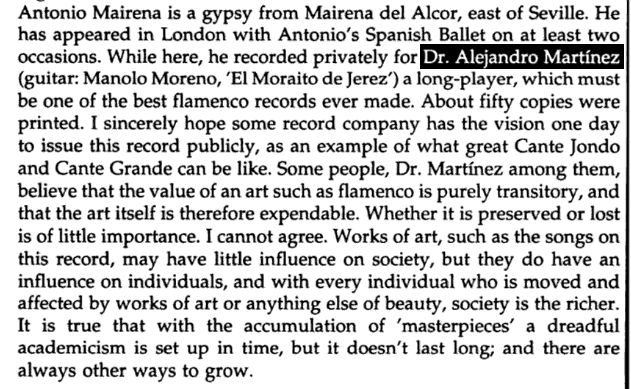
Alejandro
passed away 1978 in Lambeth,
London
Dr
Alejandro Jaun Martinez
All
Aliens RFC, Seft0n
RUFC
photographs, programmes and memorabilia Copyright © 2012
Sefton RUFC



